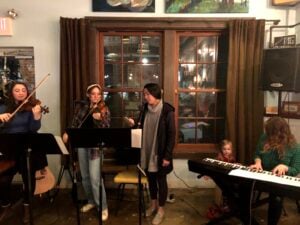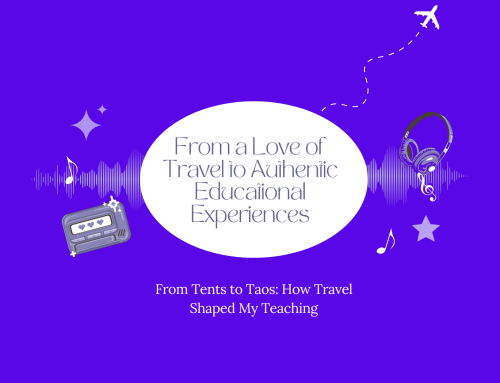I remember playing an original song at my first open mic night. I was 17 years old and a senior in high school. Until that point, I had written some original songs that I would play around with but never felt confident with my voice or playing to do anything with them. I met some friends at school interested in playing music, and we formed a little trio–acoustic guitar, keyboard, and vocals. My friend Leah had the most incredible voice I’d ever heard. If I couldn’t sing my songs, maybe she could?
If there were cell phone videos in 2003, I might have some evidence from the night. But, all I have is my memory–how nervous I was before we started and how I was afraid that others wouldn’t “get” our music.
You see, there is something distinctly different about performing for strangers than performing for your peers or school community. When you perform at an open mic, you have to capture the audience. You have to sell yourself and your songs. You have to compete for attention, and the response you get can be a window into your work. Most people aren’t there because they’re required to be there for a grade or because they love you. They are there because they want to see what you can do (or because they are a musician as well).
We played two songs. One song was about a boy I liked and another song was about a friend I fought with. I can still hear the melody for “You say you’ve changed” in my head. It wasn’t my best work, by any means, but it was mine. And, I was playing it for strangers.
How did that performance go?
As soon as we walked off stage, flush-cheeked and full of adrenaline, I was approached by a man with a smile on his face. He told me that he ran an open mic in another section of the city and that we should consider coming to play there. I was convinced. Performing my music on stage was incredible, and I would continue to pursue it to this day.
Closing gaps in education
In 2007, I was a new teacher. It’s hard to believe that I was just four years past the open mic experience that significantly impacted me. As a new teacher, I met so many students who wanted to play shows. They wanted to play their music in a space outside the school. I tried my best to help them navigate the musical landscape of our city, Philadelphia, and to give them advice I had. At the time, I was recording with a band and also working on booking shows. I learned alongside my students and shared everything I knew.
We were figuring it out together.
One common complaint was that there weren’t many venues that allowed shows for students who were under 21 years of age. AND there were no venues in the community around the school. No venues. No places for students to play music.
After a few years, I decided to find a space for my students. I made connections with a local coffee shop, Be Well Bakery and Cafe, and piloted our very first “music night.” (For more specifics on how I established this relationship and the results of a study concerning this project, check out my chapter in The Bloomsbury Handbook of Popular Music Education).
The power of the mic
It has been 7 years since our first music night at Be Well in 2014. Each time we host an open mic there, I am more convinced that this program is essential for students to find their voice. Last school year, our Be Well Show was just days before the school shut down due to the pandemic. It was the last time we made music together, unmasked, in a collective space. The memory of that night still sticks in my brain. If you were there, you would have seen:
- two students (and a teacher!) perform original songs for the first time in front of an audience
- performances from students–> both those in large ensembles at the school and those who are not involved in our music program
- performances on violin, ukulele, guitar, and keyboard
- a violinist improvise in front of an audience for the first time
- performances from student-teachers and music teachers
- music selections spanning from 1950- 2020
- excited audience members, giving their attention to performers
- an impromptu a cappella performance from members of the school’s treble choir
- my daughter (age 3) strumming the ukulele and singing during one of my student’s performances

Students performing at Be Well on March 5th, 2020
You would have also seen a student volunteer running the sound system and the entire group of students working together to both set up and tear down the show. You would have seen the smiles on their faces as they nervously sat down after each performance and received applause and hugs from friends and family. You would have seen community and students finding their voice.
If your students know explicitly that you care about every learner and every way they express their musicianship, they will be more likely to share it with you.
Before the mic
So, how do we encourage students to find their voice? To stand up in front of a class or a crowd and believe that they have something that needs to be heard and have the unique power to deliver what only their voice can do? While I am still learning how to best support students every day, I have found the following points to be true:
- Students are more likely to take risks when risk-taking is modeled. How often do you share your musical insecurities with your students? Or do something for the first time in front of them? Earlier this year, a sophomore asked me if I would write a rap to a beat he created and perform it. (This happened to occur during the unit where I encourage students to try something musical for the first time). I was terrified, but I did it! And I told my students how nervous I was and that I was going to try my best despite being outside my comfort zone. Those moments in the classroom matter. They show our students that we are all on a journey and it’s ok to make mistakes.
- Honor and validate a holistic view of musicianship. Do you have a space for budding DJs in your school? What about kids who love writing lyrics but feel insecure performing them? Or, a kid who plays well by ear but is a terrible sight-reader? Whom does your program serve? If your students know explicitly that you care about every learner and every way they express their musicianship, they will be more likely to share it with you.
- Remind students that their voice is a vehicle. As someone who was terrified to sing in front of a crowd for YEARS, I was so concerned with the sound of my voice that I neglected the power of my voice to tell a story and move people emotionally…that my voice could be a tunnel for which the music moved through, not a destination in and of itself. Have you shown students examples of the power of a voice? Have you connected them with the meaning and message in their music and focused on technique as a means to an end, not the end itself?
- Be patient. If performing in front of others has always come easy for you, you are one of the lucky few. Most of us shake in the knees at the very thought of singing or speaking in front of a crowd. If a student wants to grow in the power of their voice, start small. Give them a supportive space to start with that involves a few close friends and gradually grow their audience, reminding them that their voice holds power.
Even with everything mentioned above, sometimes all it takes is a microphone and an invitation. I am floored every year when kids seemingly come out of nowhere to sing in my collaborative arts course or perform a spoken word piece at a Be Well show. I didn’t give them a personal invitation, and I didn’t tell them they had to perform. They were simply given access to a microphone and a safe space.
What about you? What advice would you give to other teachers trying to help students find their voice?
Want more ideas for how to engage students in creative work, specifically songwriting? Check out Sarah’s book, Songwriting for Music Educators.




Leave A Comment